

A Python JSON module and lint checker - Iceweasel. Books - search.cpan.org - Iceweasel. WebService::ISBNDB::API::Books - Data class for book information use WebService::ISBNDB::API::Books; my $book = WebService::ISBNDB::API->new({ api_key => $key, isbn => '0596002068' }); This class represents book data from isbndb.com.

It is a sub-class of WebService::ISBNDB::API (see WebService::ISBNDB::API), and inherits all the attributes and methods from that class. The following methods are specific to this class, or overridden from the super-class. Constructor The constructor for this class may take a single scalar argument in lieu of a hash reference: new($ISBN|$TITLE|$ARGS) This constructs a new object and returns a referent to it.
If the argument is the hash-reference form, then a new object is always constructed; to perform searches see the search() and find() methods. ISBN converter program - C / C++ - Iceweasel. Java - parse String with Regex - Stack Overflow - Iceweasel. Rename Files with ISBN lookup - ISBN.Press.Name.Title.pdf - Iceweasel. Hi.
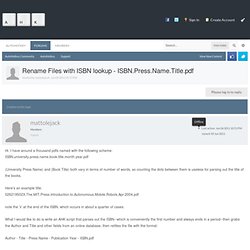
I have around a thousand pdfs named with the following scheme:ISBN.university.press.name.book.title.month.year.pdf (University Press Name) and (Book Title) both vary in terms of number of words, so counting the dots between them is useless for parsing out the title of the books. Here's an example title:026219502X.The.MIT.Press.Introduction.to.Autonomous.Mobile.Robots.Apr.2004.pdf note the 'x' at the end of the ISBN, which occurs in about a quarter of cases.
What I would like to do is write an AHK script that parses out the ISBN--which is conveniently the first number and always ends in a period--then grabs the Author and Title and other fields from an online database, then retitles the file with the format: Cb2Bib: Overview - Iceweasel. The cb2Bib is a free, open source, and multiplatform application for rapidly extracting unformatted, or unstandardized bibliographic references from email alerts, journal Web pages, and PDF files.
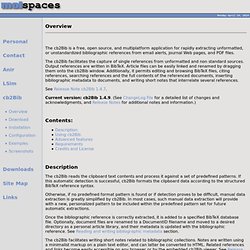
The cb2Bib facilitates the capture of single references from unformatted and non standard sources. Output references are written in BibTeX. Article files can be easily linked and renamed by dragging them onto the cb2Bib window. Additionally, it permits editing and browsing BibTeX files, citing references, searching references and the full contents of the referenced documents, inserting bibliographic metadata to documents, and writing short notes that interrelate several references.
See Release Note cb2Bib 1.4.7. Current version: cb2Bib 1.4.9. Contents: Description The cb2Bib reads the clipboard text contents and process it against a set of predefined patterns. Once the bibliographic reference is correctly extracted, it is added to a specified BibTeX database file. Using cb2Bib Procedure Requirements. Tellico Changelog. Mekk / calibre_utils / source — Bitbucket - Iceweasel. ISBN Tools: Book search, ISBN syntax, ISBN Directory - Iceweasel. Mekk.calibre 1.2.2 : Python Package Index - Iceweasel. Calibre helper scripts (ISBN guessing, RTF to DOC conversion,hanging books detection, ...).

The following scripts are available: calibre_guess_and_add_isbn Checks books without ISBN (set in metadata) for ISBN-like string present in leading pages. If found, add it to the metadata (what makes it possible to download full metadata, covers, etc). calibre_convert_docs_to_rtf Convert any .doc to .rtf (unless already present) - using openoffice. calibre_add_if_missing Checks given directory tree for books not yet present in calibre, add them if found. Calibre_find_books_missing_in_database Checks whether Calibre database directory contains some unregistered files and report them if found. calibre_report_duplicates Report duplicates, adding information of which of them are surely safe to merge (because duplicated books are identical or because formats do not overlap) and which require examination. calibre_guess_and_add_isbn.
ISBN - Wikipedia, the free encyclopedia - Iceweasel. The MediaWiki software uses magic links to automatically create links for identifiers such as International Standard Book Numbers (ISBN) without using any markup.
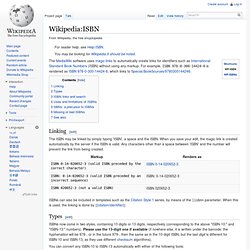
For example, ISBN 978-0-300-14424-6 is rendered as ISBN 978-0-300-14424-6, which links to Special:BookSources/9780300144246. Linking[edit] The ISBN may be linked by simply typing 'ISBN', a space and the ISBN. When you save your edit, the magic link is created automatically by the server if the ISBN is valid. Any characters other than a space between 'ISBN' and the number will prevent the link from being created. ISBNs can also be included in templates such as the Citation Style 1 series, by means of the |isbn= parameter. Types[edit] Book sources - Wikipedia, the free encyclopedia - Iceweasel. This page allows users to search for multiple sources for a book given the 10- or 13-digit ISBN number.
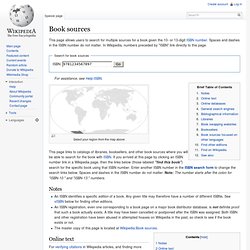
Spaces and dashes in the ISBN number do not matter. In Wikipedia, numbers preceded by "ISBN" link directly to this page. This page links to catalogs of libraries, booksellers, and other book sources where you will be able to search for the book with ISBN. If you arrived at this page by clicking an ISBN number link in a Wikipedia page, then the links below (those labeled "find this book") search for the specific book using that ISBN number. ISO 3166 - Wikipedia, the free encyclopedia - Iceweasel. Parts[edit] It consists of three parts:[1] ISO 3166-1, Codes for the representation of names of countries and their subdivisions – Part 1: Country codes, defines codes for the names of countries, dependent territories, and special areas of geographical interest.
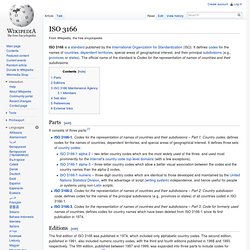
Editions[edit] The first edition of ISO 3166 was published in 1974, which included only alphabetic country codes. The second edition, published in 1981, also included numeric country codes, with the third and fourth editions published in 1988 and 1993 respectively. ISO 3166-1 numeric - Wikipedia, the free encyclopedia - Iceweasel.
ISO 3166-1 numeric (or numeric-3) codes are three-digit country codes defined in ISO 3166-1, part of the ISO 3166 standard published by the International Organization for Standardization (ISO), to represent countries, dependent territories, and special areas of geographical interest.
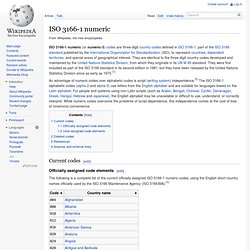
They are identical to the three-digit country codes developed and maintained by the United Nations Statistics Division, from which they originate in its UN M.49 standard. They were first included as part of the ISO 3166 standard in its second edition in 1981, but they have been released by the United Nations Statistics Division since as early as 1970.[1] ISO 3166-1 alpha-3 - Wikipedia, the free encyclopedia - Iceweasel. ISO 3166-1 alpha-3 codes are three-letter country codes defined in ISO 3166-1, part of the ISO 3166 standard published by the International Organization for Standardization (ISO), to represent countries, dependent territories, and special areas of geographical interest.
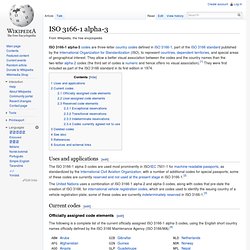
They allow a better visual association between the codes and the country names than the two-letter alpha-2 codes (the third set of codes is numeric and hence offers no visual association).[1] They were first included as part of the ISO 3166 standard in its first edition in 1974. Uses and applications[edit] The ISO 3166-1 alpha-3 codes are used most prominently in ISO/IEC 7501-1 for machine-readable passports, as standardized by the International Civil Aviation Organization, with a number of additional codes for special passports; some of these codes are currently reserved and not used at the present stage in ISO 3166-1.[2] Current codes[edit] Officially assigned code elements[edit]
ISO 3166-1 - Wikipedia, the free encyclopedia - Iceweasel. A map of Europe, with ISO 3166-1 alpha-2 codes in place of the names of countries and other territories.
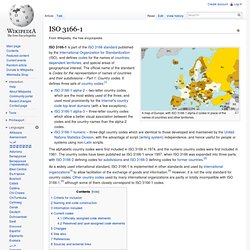
ISO 3166-1 is part of the ISO 3166 standard published by the International Organization for Standardization (ISO), and defines codes for the names of countries, dependent territories, and special areas of geographical interest. The official name of the standard is Codes for the representation of names of countries and their subdivisions – Part 1: Country codes. It defines three sets of country codes:[1] The alphabetic country codes were first included in ISO 3166 in 1974, and the numeric country codes were first included in 1981. GS1 - The global language of business - Iceweasel. GS1 - Wikipedia, the free encyclopedia - Iceweasel. GS1 is a neutral, not-for-profit, international organisation that develops and maintains standards for supply and demand chains across multiple sectors.
With local Member Organisations in over 110 countries, GS1 works with communities of trading partners, industry organisations, governments and technology providers and responds to their business needs through the adoption and implementation of global standards. GS1 has over a million member companies across the world, executing more than six billion transactions daily using GS1 standards. GS1 logo GS1 standards[edit] Most companies initially come to GS1 to get a bar code number for their products. Identify: Standards for the identification of items, locations, shipments, assets, etc.. and associated dataCapture: Standards for encoding and capturing data in physical data carriers such as barcodes and RFID tagsShare: Standards for sharing data between parties. Check digit - Wikipedia, the free encyclopedia - Iceweasel.
A check digit is a form of redundancy check used for error detection on identification numbers (e.g. bank account numbers) which have been input manually. It is analogous to a binary parity bit used to check for errors in computer-generated data. It consists of a single digit (sometimes more than one) computed by an algorithm from the other digits (or letters) in the sequence input.
ISBN Tools: Gory Details - Iceweasel. Template:ISBN missing - Wikipedia, the free encyclopedia - Iceweasel. [ISBN missing] This template is an in-line request for the ISBN of a published source. {{ISBN missing}} is an inline cleanup template flagging a broken source citation that is missing the ISBN of the cited source.
Usage[edit] {{ISBN missing|date=April 2014}} List of pages with Invalid ISBNs - Wikipedia, the free encyclopedia - Iceweasel. Template:ISBN - Wikipedia, the free encyclopedia - Iceweasel. There is currently no consensus on where to place this template in an article but above the reference list is probably the most acceptable. The simplest way to add this template to an article is to copy and paste {{ISBN|date=April 2014}}. Usage Use this to note that some or all books cited do not have their ISBNs included in the article.
WP:CITE does not require that ISBNs be added. This template should therefore not be restored over objections. Do not use this template to identify books that were never assigned ISBNs by their publishers. Note that this template is not required for inserting an ISBN into an article; the Mediawiki software recognizes ISBNs automatically. Entering ISBNs This template is not for providing links for ISBNs. Instead simply type ISBN before the number with a space but not a colon. In tables (or other applications) where the letters ISBN would be redundant the ISBNT template may be used instead. ISO 3166-1 alpha-2 - Wikipedia, the free encyclopedia - Iceweasel. List of GS1 country codes - Wikipedia, the free encyclopedia - Iceweasel. List of GS1 country codes called GS1 Prefixes.
Note: from official GS1 website "The GS1 Prefix, the first three digits, usually identifying the national GS1 Member Organization to which the manufacturer is registered (not necessarily where the product is actually made). " Prefix 950 (GS1 Global Office) is used for special applications and bi-lateral agreements. Prefix 951 is used by EPCglobal. From the 960 range, prefixes 9600 to 9604 have been assigned to GS1 UK for GTIN-8 number allocations. See also[edit] Global Trade Item Number - Wikipedia, the free encyclopedia - Iceweasel. Global Trade Item Number (GTIN) is an identifier for trade items developed by GS1 (comprising among others of the former EAN International and Uniform Code Council)[citation needed].
International Standard Book Number - Wikipedia, the free encyclopedia - Iceweasel. The International Standard Book Number (ISBN) is a unique[1][2] numeric commercial book identifier based upon the 9-digit Standard Book Numbering (SBN) code created by Gordon Foster, Emeritus Professor of Statistics at Trinity College, Dublin,[3] for the booksellers and stationers WHSmith and others in 1965.[4]
Book sources - Wikipedia, the free encyclopedia - Iceweasel. Regular Expressions - Iceweasel. Regular Expressions - Iceweasel.